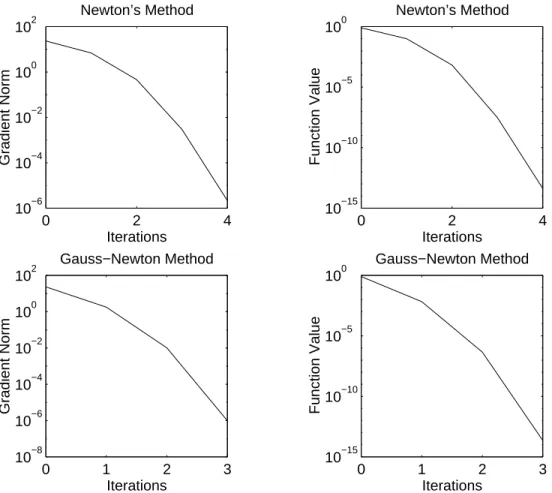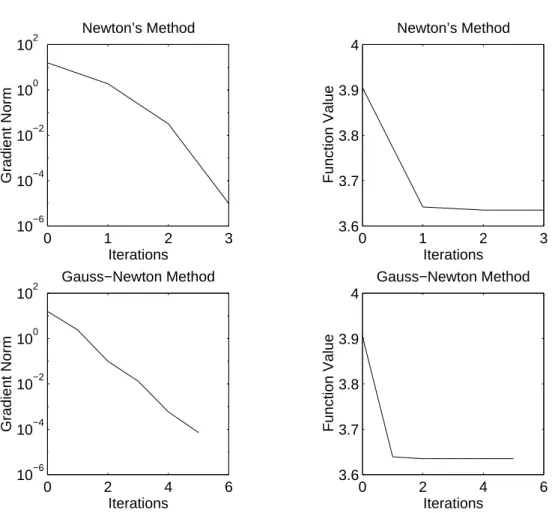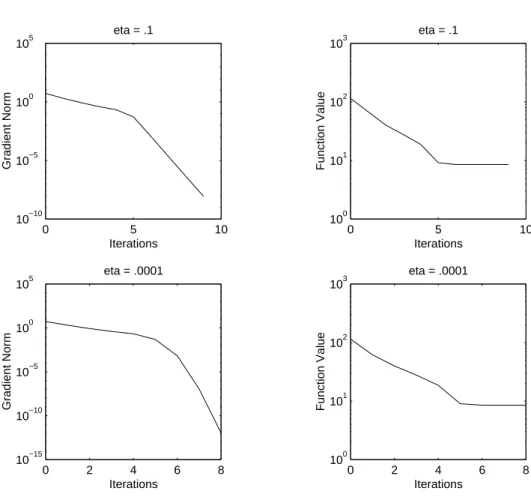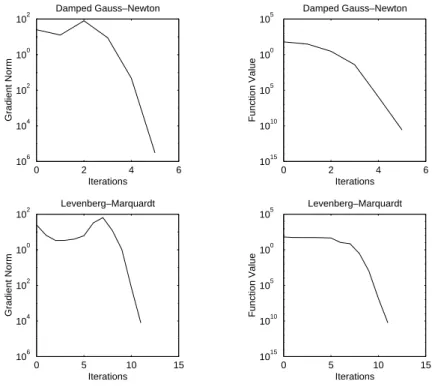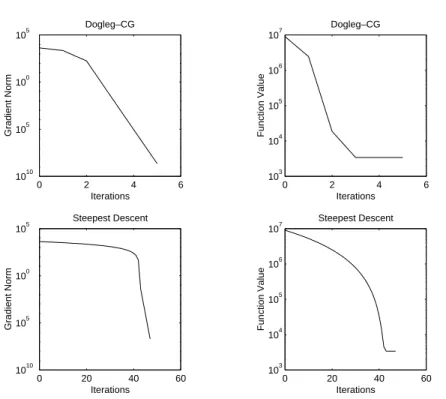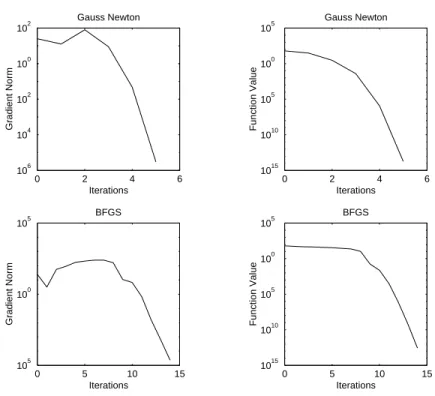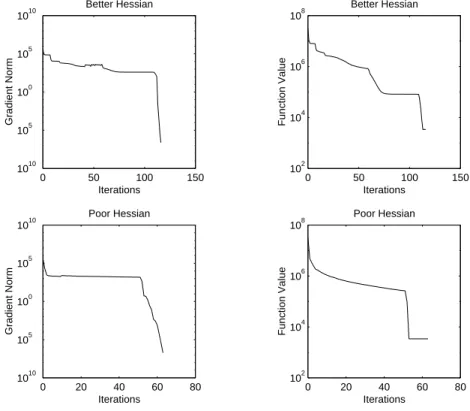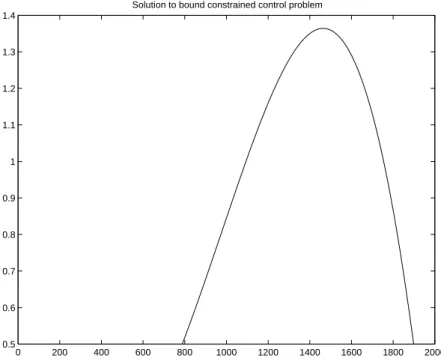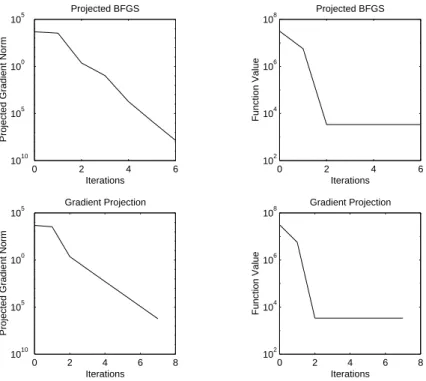Iterative Methods for Optimization
C.T. Kelley
North Carolina State University Raleigh, North Carolina
Society for Industrial and Applied Mathematics
Philadelphia
Contents
Preface xiii
How to Get the Software xv
I Optimization of Smooth Functions 1
1 Basic Concepts 3
1.1 The Problem . . . . 3
1.2 Notation . . . . 4
1.3 Necessary Conditions . . . . 5
1.4 Sufficient Conditions . . . . 6
1.5 Quadratic Objective Functions . . . . 6
1.5.1 Positive Definite Hessian . . . . 7
1.5.2 Indefinite Hessian . . . . 9
1.6 Examples . . . . 9
1.6.1 Discrete Optimal Control . . . . 9
1.6.2 Parameter Identification . . . . 11
1.6.3 Convex Quadratics . . . . 12
1.7 Exercises on Basic Concepts . . . . 12
2 Local Convergence of Newton’s Method 13 2.1 Types of Convergence . . . . 13
2.2 The Standard Assumptions . . . . 14
2.3 Newton’s Method . . . . 14
2.3.1 Errors in Functions, Gradients, and Hessians . . . . 17
2.3.2 Termination of the Iteration . . . . 21
2.4 Nonlinear Least Squares . . . . 22
2.4.1 Gauss–Newton Iteration . . . . 23
2.4.2 Overdetermined Problems . . . . 24
2.4.3 Underdetermined Problems . . . . 25
2.5 Inexact Newton Methods . . . . 28
2.5.1 Convergence Rates . . . . 29
2.5.2 Implementation of Newton–CG . . . . 30
2.6 Examples . . . . 33
2.6.1 Parameter Identification . . . . 33
2.6.2 Discrete Control Problem . . . . 34
2.7 Exercises on Local Convergence . . . . 35
x CONTENTS
3 Global Convergence 39
3.1 The Method of Steepest Descent . . . . 39
3.2 Line Search Methods and the Armijo Rule . . . . 40
3.2.1 Stepsize Control with Polynomial Models . . . . 43
3.2.2 Slow Convergence of Steepest Descent . . . . 45
3.2.3 Damped Gauss–Newton Iteration . . . . 47
3.2.4 Nonlinear Conjugate Gradient Methods . . . . 48
3.3 Trust Region Methods . . . . 50
3.3.1 Changing the Trust Region and the Step . . . . 51
3.3.2 Global Convergence of Trust Region Algorithms . . . . 52
3.3.3 A Unidirectional Trust Region Algorithm . . . . 54
3.3.4 The Exact Solution of the Trust Region Problem . . . . 55
3.3.5 The Levenberg–Marquardt Parameter . . . . 56
3.3.6 Superlinear Convergence: The Dogleg . . . . 58
3.3.7 A Trust Region Method for Newton–CG . . . . 63
3.4 Examples . . . . 65
3.4.1 Parameter Identification . . . . 67
3.4.2 Discrete Control Problem . . . . 68
3.5 Exercises on Global Convergence . . . . 68
4 The BFGS Method 71 4.1 Analysis . . . . 72
4.1.1 Local Theory . . . . 72
4.1.2 Global Theory . . . . 77
4.2 Implementation . . . . 78
4.2.1 Storage . . . . 78
4.2.2 A BFGS–Armijo Algorithm . . . . 80
4.3 Other Quasi-Newton Methods . . . . 81
4.4 Examples . . . . 83
4.4.1 Parameter ID Problem . . . . 83
4.4.2 Discrete Control Problem . . . . 83
4.5 Exercises on BFGS . . . . 85
5 Simple Bound Constraints 87 5.1 Problem Statement . . . . 87
5.2 Necessary Conditions for Optimality . . . . 87
5.3 Sufficient Conditions . . . . 89
5.4 The Gradient Projection Algorithm . . . . 91
5.4.1 Termination of the Iteration . . . . 91
5.4.2 Convergence Analysis . . . . 93
5.4.3 Identification of the Active Set . . . . 95
5.4.4 A Proof of Theorem 5.2.4 . . . . 96
5.5 Superlinear Convergence . . . . 96
5.5.1 The Scaled Gradient Projection Algorithm . . . . 96
5.5.2 The Projected Newton Method . . . 100
5.5.3 A Projected BFGS–Armijo Algorithm . . . 102
5.6 Other Approaches . . . 104
5.6.1 Infinite-Dimensional Problems . . . 106
5.7 Examples . . . 106
5.7.1 Parameter ID Problem . . . 106
5.7.2 Discrete Control Problem . . . 106
5.8 Exercises on Bound Constrained Optimization . . . 108
II Optimization of Noisy Functions 109 6 Basic Concepts and Goals 111 6.1 Problem Statement . . . 112
6.2 The Simplex Gradient . . . 112
6.2.1 Forward Difference Simplex Gradient . . . 113
6.2.2 Centered Difference Simplex Gradient . . . 115
6.3 Examples . . . 118
6.3.1 Weber’s Problem . . . 118
6.3.2 Perturbed Convex Quadratics . . . 119
6.3.3 Lennard–Jones Problem . . . 120
6.4 Exercises on Basic Concepts . . . 121
7 Implicit Filtering 123 7.1 Description and Analysis of Implicit Filtering . . . 123
7.2 Quasi-Newton Methods and Implicit Filtering . . . 124
7.3 Implementation Considerations . . . 125
7.4 Implicit Filtering for Bound Constrained Problems . . . 126
7.5 Restarting and Minima at All Scales . . . 127
7.6 Examples . . . 127
7.6.1 Weber’s Problem . . . 127
7.6.2 Parameter ID . . . 129
7.6.3 Convex Quadratics . . . 129
7.7 Exercises on Implicit Filtering . . . 133
8 Direct Search Algorithms 135 8.1 The Nelder–Mead Algorithm . . . 135
8.1.1 Description and Implementation . . . 135
8.1.2 Sufficient Decrease and the Simplex Gradient . . . 137
8.1.3 McKinnon’s Examples . . . 139
8.1.4 Restarting the Nelder–Mead Algorithm . . . 141
8.2 Multidirectional Search . . . 143
8.2.1 Description and Implementation . . . 143
8.2.2 Convergence and the Simplex Gradient . . . 144
8.3 The Hooke–Jeeves Algorithm . . . 145
8.3.1 Description and Implementation . . . 145
8.3.2 Convergence and the Simplex Gradient . . . 148
8.4 Other Approaches . . . 148
8.4.1 Surrogate Models . . . 148
8.4.2 The DIRECT Algorithm . . . 149
8.5 Examples . . . 152
8.5.1 Weber’s Problem . . . 152
8.5.2 Parameter ID . . . 153
8.5.3 Convex Quadratics . . . 153
8.6 Exercises on Search Algorithms . . . 159
xii CONTENTS
Bibliography 161
Index 177
Preface
This book on unconstrained and bound constrained optimization can be used as a tutorial for self-study or a reference by those who solve such problems in their work. It can also serve as a textbook in an introductory optimization course.
As in my earlier book [154] on linear and nonlinear equations, we treat a small number of methods in depth, giving a less detailed description of only a few (for example, the nonlinear conjugate gradient method and the DIRECT algorithm). We aim for clarity and brevity rather than complete generality and confine our scope to algorithms that are easy to implement (by the reader!) and understand.
One consequence of this approach is that the algorithms in this book are often special cases of more general ones in the literature. For example, in Chapter 3, we provide details only for trust region globalizations of Newton’s method for unconstrained problems and line search globalizations of the BFGS quasi-Newton method for unconstrained and bound constrained problems. We refer the reader to the literature for more general results. Our intention is that both our algorithms and proofs, being special cases, are more concise and simple than others in the literature and illustrate the central issues more clearly than a fully general formulation.
Part II of this book covers some algorithms for noisy or global optimization or both. There are many interesting algorithms in this class, and this book is limited to those deterministic algorithms that can be implemented in a more-or-less straightforward way. We do not, for example, cover simulated annealing, genetic algorithms, response surface methods, or random search procedures.
The reader of this book should be familiar with the material in an elementary graduate level course in numerical analysis, in particular direct and iterative methods for the solution of linear equations and linear least squares problems. The material in texts such as [127] and [264] is sufficient.
A suite of MATLAB
∗codes has been written to accompany this book. These codes were used to generate the computational examples in the book, but the algorithms do not depend on the MATLAB environment and the reader can easily implement the algorithms in another language, either directly from the algorithmic descriptions or by translating the MATLAB code.
The MATLAB environment is an excellent choice for experimentation, doing the exercises, and small-to-medium-scale production work. Large-scale work on high-performance computers is best done in another language. The reader should also be aware that there is a large amount of high-quality software available for optimization. The book [195], for example, provides pointers to several useful packages.
Parts of this book are based upon work supported by the National Science Foundation over several years, most recently under National Science Foundation grants DMS-9321938, DMS- 9700569, and DMS-9714811, and by allocations of computing resources from the North Carolina Supercomputing Center. Any opinions, findings, and conclusions or recommendations expressed
∗
MATLAB is a registered trademark of The MathWorks, Inc., 24 Prime Park Way, Natick, MA 01760, USA, (508)
653-1415, info@mathworks.com, http://www.mathworks.com.
xiv PREFACE in this material are those of the author and do not necessarily reflect the views of the National Science Foundation or of the North Carolina Supercomputing Center.
The list of students and colleagues who have helped me with this project, directly, through collaborations/discussions on issues that I treat in the manuscript, by providing pointers to the literature, or as a source of inspiration, is long. I am particularly indebted to Tom Banks, Jim Banoczi, John Betts, David Bortz, Steve Campbell, Tony Choi, Andy Conn, Douglas Cooper, Joe David, John Dennis, Owen Eslinger, J¨org Gablonsky, Paul Gilmore, Matthias Heinkenschloß, Laura Helfrich, Lea Jenkins, Vickie Kearn, Carl and Betty Kelley, Debbie Lockhart, Casey Miller, Jorge Mor´e, Mary Rose Muccie, John Nelder, Chung-Wei Ng, Deborah Poulson, Ekkehard Sachs, Dave Shanno, Joseph Skudlarek, Dan Sorensen, John Strikwerda, Mike Tocci, Jon Tolle, Virginia Torczon, Floria Tosca, Hien Tran, Margaret Wright, Steve Wright, and Kevin Yoemans.
C. T. Kelley
Raleigh, North Carolina
How to Get the Software
All computations reported in this book were done in MATLAB (version 5.2 on various SUN SPARCstations and on an Apple Macintosh Powerbook 2400). The suite of MATLAB codes that we used for the examples is available by anonymous ftp from ftp.math.ncsu.edu in the directory FTP/kelley/optimization/matlab
or from SIAM’s World Wide Web server at http://www.siam.org/books/fr18/
One can obtain MATLAB from The MathWorks, Inc.
3 Apple Hill Drive Natick, MA 01760-2098 (508) 647-7000
Fax: (508) 647-7001
E-mail: info@mathworks.com
WWW: http://www.mathworks.com
Part I
Optimization of Smooth Functions
Chapter 1
Basic Concepts
1.1 The Problem
The unconstrained optimization problem is to minimize a real-valued function f of N variables.
By this we mean to find a local minimizer, that is, a point x
∗such that f (x
∗) ≤ f (x) for all x near x
∗. (1.1)
It is standard to express this problem as
min x f (x) (1.2)
or to say that we seek to solve the problem min f . The understanding is that (1.1) means that we seek a local minimizer. We will refer to f as the objective function and to f (x
∗) as the minimum or minimum value. If a local minimizer x
∗exists, we say a minimum is attained at x
∗.
We say that problem (1.2) is unconstrained because we impose no conditions on the inde- pendent variables x and assume that f is defined for all x .
The local minimization problem is different from (and much easier than) the global mini- mization problem in which a global minimizer, a point x
∗such that
f (x
∗) ≤ f (x) for all x , (1.3)
is sought.
The constrained optimization problem is to minimize a function f over a set U ⊂ R N . A local minimizer, therefore, is an x
∗∈ U such that
f (x
∗) ≤ f (x) for all x ∈ U near x
∗. (1.4)
Similar to (1.2) we express this as
min x∈U f (x) (1.5)
or say that we seek to solve the problem min U f . A global minimizer is a point x
∗∈ U such that
f (x
∗) ≤ f (x) for all x ∈ U . (1.6)
We consider only the simplest constrained problems in this book (Chapter 5 and § 7.4) and refer the reader to [104], [117], [195], and [66] for deeper discussions of constrained optimization and pointers to software.
Having posed an optimization problem one can proceed in the classical way and use methods
that require smoothness of f . That is the approach we take in this first part of the book. These
methods can fail if the objective function has discontinuities or irregularities. Such nonsmooth effects are common and can be caused, for example, by truncation error in internal calculations for f , noise in internal probabilistic modeling in f , table lookup within f , or use of experimental data in f . We address a class of methods for dealing with such problems in Part II.
1.2 Notation
In this book, following the convention in [154], vectors are to be understood as column vectors.
The vector x
∗will denote a solution, x a potential solution, and {x k } k≥0 the sequence of iterates.
We will refer to x
0as the initial iterate. x
0is sometimes timidly called the initial guess. We will denote the i th component of a vector x by (x) i (note the parentheses) and the i th component of x k by (x k ) i . We will rarely need to refer to individual components of vectors. We will let
∂f/∂x i denote the partial derivative of f with respect to (x) i . As is standard [154], e = x − x
∗will denote the error, e n = x n − x
∗the error in the n th iterate, and B(r) the ball of radius r about x
∗B(r) = {x | e < r}.
For x ∈ R N we let ∇f (x) ∈ R N denote the gradient of f ,
∇f (x) = (∂f/∂x
1, . . . , ∂f/∂x N ), when it exists.
We let ∇
2f denote the Hessian of f ,
(∇
2f ) ij = ∂
2f/∂x i ∂x j ,
when it exists. Note that ∇
2f is the Jacobian of ∇f . However, ∇
2f has more structure than a Jacobian for a general nonlinear function. If f is twice continuously differentiable, then the Hessian is symmetric ( (∇
2f ) ij = (∇
2f ) ji ) by equality of mixed partial derivatives [229].
In this book we will consistently use the Euclidean norm x =
N
i=1
(x)
2i .
When we refer to a matrix norm we will mean the matrix norm induced by the Euclidean norm A = max
x=0
Ax x .
In optimization definiteness or semidefiniteness of the Hessian plays an important role in the necessary and sufficient conditions for optimality that we discuss in § 1.3 and 1.4 and in our choice of algorithms throughout this book.
Definition 1.2.1. An N ×N matrix A is positive semidefinite if x T Ax ≥ 0 for all x ∈ R N . A is positive definite if x T Ax > 0 for all x ∈ R N , x = 0 . If A has both positive and negative eigenvalues, we say A is indefinite. If A is symmetric and positive definite, we will say A is spd.
We will use two forms of the fundamental theorem of calculus, one for the function–gradient pair and one for the gradient–Hessian.
Theorem 1.2.1. Let f be twice continuously differentiable in a neighborhood of a line segment between points x
∗, x = x
∗+ e ∈ R N ; then
f (x) = f (x
∗) +
10
∇f (x
∗+ te) T e dt
BASIC CONCEPTS 5 and
∇f(x) = ∇f (x
∗) +
10
∇
2f(x
∗+ te)e dt.
A direct consequence (see Exercise 1.7.1) of Theorem 1.2.1 is the following form of Taylor’s theorem we will use throughout this book.
Theorem 1.2.2. Let f be twice continuously differentiable in a neighborhood of a point x
∗∈ R N . Then for e ∈ R N and e sufficiently small
f (x
∗+ e) = f (x
∗) + ∇f (x
∗) T e + e T ∇
2f (x
∗)e/2 + o(e
2).
(1.7)
1.3 Necessary Conditions
Let f be twice continuously differentiable. We will use Taylor’s theorem in a simple way to show that the gradient of f vanishes at a local minimizer and the Hessian is positive semidefinite.
These are the necessary conditions for optimality.
The necessary conditions relate (1.1) to a nonlinear equation and allow one to use fast al- gorithms for nonlinear equations [84], [154], [211] to compute minimizers. Therefore, the necessary conditions for optimality will be used in a critical way in the discussion of local con- vergence in Chapter 2. A critical first step in the design of an algorithm for a new optimization problem is the formulation of necessary conditions. Of course, the gradient vanishes at a maxi- mum, too, and the utility of the nonlinear equations formulation is restricted to a neighborhood of a minimizer.
Theorem 1.3.1. Let f be twice continuously differentiable and let x
∗be a local minimizer of f . Then
∇f (x
∗) = 0.
Moreover ∇
2f (x
∗) is positive semidefinite.
Proof. Let u ∈ R N be given. Taylor’s theorem states that for all real t sufficiently small f (x
∗+ tu) = f (x
∗) + t∇f (x
∗) T u + t
22 u T ∇
2f (x
∗)u + o(t
2).
Since x
∗is a local minimizer we must have for t sufficiently small 0 ≤ f (x
∗+ tu) − f (x
∗) and hence
∇f (x
∗) T u + t
2 u T ∇
2f (x
∗)u + o(t) ≥ 0 (1.8)
for all t sufficiently small and all u ∈ R N . So if we set t = 0 and u = −∇f (x
∗) we obtain
∇f (x
∗)
2= 0.
Setting ∇f(x
∗) = 0 , dividing by t , and setting t = 0 in (1.8), we obtain 1
2 u T ∇
2f (x
∗)u ≥ 0 for all u ∈ R N . This completes the proof.
The condition that ∇f (x
∗) = 0 is called the first-order necessary condition and a point
satisfying that condition is called a stationary point or a critical point.
1.4 Sufficient Conditions
A stationary point need not be a minimizer. For example, the function φ(t) = −t
4satisfies the necessary conditions at 0 , which is a maximizer of φ . To obtain a minimizer we must require that the second derivative be nonnegative. This alone is not sufficient (think of φ(t) = t
3) and only if the second derivative is strictly positive can we be completely certain. These are the sufficient conditions for optimality.
Theorem 1.4.1. Let f be twice continuously differentiable in a neighborhood of x
∗. Assume that ∇f (x
∗) = 0 and that ∇
2f (x
∗) is positive definite. Then x
∗is a local minimizer of f .
Proof. Let 0 = u ∈ R N . For sufficiently small t we have f (x
∗+ tu) = f (x
∗) + t∇f (x
∗) T u + t
22 u T ∇
2f (x
∗)u + o(t
2)
= f (x
∗) + t
22 u T ∇
2f (x
∗)u + o(t
2).
Hence, if λ > 0 is the smallest eigenvalue of ∇
2f (x
∗) we have f (x
∗+ tu) − f (x
∗) ≥ λ
2 tu
2+ o(t
2) > 0 for t sufficiently small. Hence x
∗is a local minimizer.
1.5 Quadratic Objective Functions
The simplest optimization problems are those with quadratic objective functions. Here f (x) = −x T b + 1
2 x T Hx.
(1.9)
We may, without loss of generality, assume that H is symmetric because x T Hx = x T
H + H T 2
x.
(1.10)
Quadratic functions form the basis for most of the algorithms in Part I, which approximate an objective function f by a quadratic model and minimize that model. In this section we discuss some elementary issues in quadratic optimization.
Clearly,
∇
2f(x) = H for all x . The symmetry of H implies that
∇f (x) = −b + Hx.
Definition 1.5.1. The quadratic function f in (1.9) is convex if H is positive semidefinite.
BASIC CONCEPTS 7
1.5.1 Positive Definite Hessian
The necessary conditions for optimality imply that if a quadratic function f has a local minimum x
∗, then H is positive semidefinite and
Hx
∗= b.
(1.11)
In particular, if H is spd (and hence nonsingular), the unique global minimizer is the solution of the linear system (1.11).
If H is a dense matrix and N is not too large, it is reasonable to solve (1.11) by computing the Cholesky factorization [249], [127] of H
H = LL T ,
where L is a nonsingular lower triangular matrix with positive diagonal, and then solving (1.11) by two triangular solves. If H is indefinite the Cholesky factorization will not exist and the standard implementation [127], [249], [264] will fail because the computation of the diagonal of L will require a real square root of a negative number or a division by zero.
If N is very large, H is sparse, or a matrix representation of H is not available, a more efficient approach is the conjugate gradient iteration [154], [141]. This iteration requires only matrix–vector products, a feature which we will use in a direct way in §§ 2.5 and 3.3.7. Our formulation of the algorithm uses x as both an input and output variable. On input x contains x
0, the initial iterate, and on output the approximate solution. We terminate the iteration if the relative residual is sufficiently small, i.e.,
b − Hx ≤ b or if too many iterations have been taken.
Algorithm 1.5.1. cg (x, b, H, , kmax) 1. r = b − Hx , ρ
0= r
2, k = 1 .
2. Do While √ ρ k−1 > b and k < kmax (a) if k = 1 then p = r
else β = ρ k−1 /ρ k−2 and p = r + βp (b) w = Hp
(c) α = ρ k−1 /p T w (d) x = x + αp (e) r = r − αw (f) ρ k = r
2(g) k = k + 1
Note that if H is not spd, the denominator in α = ρ k−1 /p T w may vanish, resulting in breakdown of the iteration.
The conjugate gradient iteration minimizes f over an increasing sequence of nested subspaces of R N [127], [154]. We have that
f (x k ) ≤ f (x) for all x ∈ x
0+ K k ,
where K k is the Krylov subspace
K k = span (r
0, Hr
0, . . . , H k−1 r
0) for k ≥ 1 .
While in principle the iteration must converge after N iterations and conjugate gradient can be regarded as a direct solver, N is, in practice, far too many iterations for the large problems to which conjugate gradient is applied. As an iterative method, the performance of the conjugate gradient algorithm depends both on b and on the spectrum of H (see [154] and the references cited therein). A general convergence estimate [68], [60], which will suffice for the discussion here, is
x k − x
∗H ≤ 2x
0− x
∗H κ(H ) − 1 κ(H ) + 1
k . (1.12)
In (1.12), the H -norm of a vector is defined by
u
2H = u T Hu for an spd matrix H . κ(H ) is the l
2condition number
κ(H ) = H H
−1. For spd H
κ(H) = λ l λ
−1s ,
where λ l and λ s are the largest and smallest eigenvalues of H . Geometrically, κ(H ) is large if the ellipsoidal level surfaces of f are very far from spherical.
The conjugate gradient iteration will perform well if κ(H) is near 1 and may perform very poorly if κ(H) is large. The performance can be improved by preconditioning, which transforms (1.11) into one with a coefficient matrix having eigenvalues near 1. Suppose that M is spd and a sufficiently good approximation to H
−1so that
κ(M
1/2HM
1/2)
is much smaller that κ(H ) . In that case, (1.12) would indicate that far fewer conjugate gradient iterations might be needed to solve
M
1/2HM
1/2z = M
1/2b (1.13)
than to solve (1.11). Moreover, the solution x
∗of (1.11) could be recovered from the solution z
∗of (1.13) by
x = M
1/2z.
(1.14)
In practice, the square root of the preconditioning matrix M need not be computed. The algo- rithm, using the same conventions that we used for cg, is
Algorithm 1.5.2. pcg (x, b, H, M, , kmax) 1. r = b − Hx , ρ
0= r
2, k = 1
2. Do While √ ρ k−1 > b and k < kmax (a) z = Mr
(b) τ k−1 = z T r
BASIC CONCEPTS 9 (c) if k = 1 then β = 0 and p = z
else β = τ k−1 /τ k−2 , p = z + βp (d) w = Hp
(e) α = τ k−1 /p T w (f) x = x + αp (g) r = r − αw (h) ρ k = r T r
(i) k = k + 1
Note that only products of M with vectors in R N are needed and that a matrix representation of M need not be stored. We refer the reader to [11], [15], [127], and [154] for more discussion of preconditioners and their construction.
1.5.2 Indefinite Hessian
If H is indefinite, the necessary conditions, Theorem 1.3.1, imply that there will be no local minimum. Even so, it will be important to understand some properties of quadratic problems with indefinite Hessians when we design algorithms with initial iterates far from local minimizers and we discuss some of the issues here.
If
u T Hu < 0,
we say that u is a direction of negative curvature. If u is a direction of negative curvature, then f (x + tu) will decrease to −∞ as t → ∞ .
1.6 Examples
It will be useful to have some example problems to solve as we develop the algorithms. The examples here are included to encourage the reader to experiment with the algorithms and play with the MATLAB codes. The codes for the problems themselves are included with the set of MATLAB codes. The author of this book does not encourage the reader to regard the examples as anything more than examples. In particular, they are not real-world problems, and should not be used as an exhaustive test suite for a code. While there are documented collections of test problems (for example, [10] and [26]), the reader should always evaluate and compare algorithms in the context of his/her own problems.
Some of the problems are directly related to applications. When that is the case we will cite some of the relevant literature. Other examples are included because they are small, simple, and illustrate important effects that can be hidden by the complexity of more serious problems.
1.6.1 Discrete Optimal Control
This is a classic example of a problem in which gradient evaluations cost little more than function evaluations.
We begin with the continuous optimal control problems and discuss how gradients are com-
puted and then move to the discretizations. We will not dwell on the functional analytic issues
surrounding the rigorous definition of gradients of maps on function spaces, but the reader should
be aware that control problems require careful attention to this. The most important results can
be found in [151]. The function space setting for the particular control problems of interest in this section can be found in [170], [158], and [159], as can a discussion of more general problems.
The infinite-dimensional problem is
min u f, (1.15)
where
f (u) = T
0
L(y(t), u(t), t) dt, (1.16)
and we seek an optimal point u ∈ L
∞[0, T ] . u is called the control variable or simply the control. The function L is given and y , the state variable, satisfies the initial value problem (with y ˙ = dy/dt )
˙
y(t) = φ(y(t), u(t), t), y(0) = y
0. (1.17)
One could view the problem (1.15)–(1.17) as a constrained optimization problem or, as we do here, think of the evaluation of f as requiring the solution of (1.17) before the integral on the right side of (1.16) can be evaluated. This means that evaluation of f requires the solution of (1.17), which is called the state equation.
∇f (u) , the gradient of f at u with respect to the L
2inner product, is uniquely determined, if it exists, by
f (u + w) − f (u) − T
0
(∇f (u))(t)w(t) dt = o(w) (1.18)
as w → 0 , uniformly in w . If ∇f (u) exists then T
0
(∇f (u))(t)w(t) dt = df(u + ξw) dξ
ξ=0 .
If L and φ are continuously differentiable, then ∇f (u) , as a function of t , is given by
∇f (u)(t) = p(t)φ u (y(t), u(t), t) + L u (y(t), u(t), t).
(1.19)
In (1.19) p , the adjoint variable, satisfies the final-value problem on [0, T ]
− p(t) = ˙ p(t)φ y (y(t), u(t), t) + L y (y(t), u(t), t), p(T ) = 0.
(1.20)
So computing the gradient requires u and y , hence a solution of the state equation, and p , which requires a solution of (1.20), a final-value problem for the adjoint equation. In the general case, (1.17) is nonlinear, but (1.20) is a linear problem for p , which should be expected to be easier to solve. This is the motivation for our claim that a gradient evaluation costs little more than a function evaluation.
The discrete problems of interest here are constructed by solving (1.17) by numerical in- tegration. After doing that, one can derive an adjoint variable and compute gradients using a discrete form of (1.19). However, in [139] the equation for the adjoint variable of the discrete problem is usually not a discretization of (1.20). For the forward Euler method, however, the discretization of the adjoint equation is the adjoint equation for the discrete problem and we use that discretization here for that reason.
The fully discrete problem is min u f , where u ∈ R N and f(u) = N
j=1
L((y) j , (u) j , j),
BASIC CONCEPTS 11 and the states {x j } are given by the Euler recursion
y j+1 = y j + hφ((y) j , (u) j , j) for j = 0, . . . , N − 1, where h = T/(N − 1) and x
0is given. Then
(∇f (u)) j = (p) j φ u ((y) j , (u) j , j) + L u ((y) j , (u) j , j), where (p) N = 0 and
(p) j−1 = (p) j + h
(p) j φ y ((y) j , (u) j , j) + L y ((y) j , (u) j , j)
for j = N, . . . , 1.
1.6.2 Parameter Identification
This example, taken from [13], will appear throughout the book. The problem is small with N = 2 . The goal is to identify the damping c and spring constant k of a linear spring by minimizing the difference of a numerical prediction and measured data. The experimental scenario is that the spring-mass system will be set into motion by an initial displacement from equilibrium and measurements of displacements will be taken at equally spaced increments in time.
The motion of an unforced harmonic oscillator satisfies the initial value problem u
+ cu
+ ku = 0; u(0) = u
0, u
(0) = 0,
(1.21)
on the interval [0, T ] . We let x = (c, k) T be the vector of unknown parameters and, when the dependence on the parameters needs to be explicit, we will write u(t : x) instead of u(t) for the solution of (1.21). If the displacement is sampled at {t j } M j=1 , where t j = (j − 1)T/(M − 1) , and the observations for u are {u j } M j=1 , then the objective function is
f (x) = 1 2
M j=1
|u(t j : x) − u j |
2. (1.22)
This is an example of a nonlinear least squares problem.
u is differentiable with respect to x when c
2− 4k = 0 . In that case, the gradient of f is
∇f (x) = M j=1 M ∂u(t ∂c
j:x)(u(t j : x) − u j )
j=1 ∂u(t
j:x)∂k (u(t j : x) − u j )
. (1.23)
We can compute the derivatives of u(t : x) with respect to the parameters by solving the sensitivity equations. Differentiating (1.21) with respect to c and k and setting w
1= ∂u/∂c and w
2= ∂u/∂k we obtain
w
1+ u
+ cw
1+ kw
1= 0; w
1(0) = w
1(0) = 0, w
2+ cw
2+ u + kw
2= 0; w
2(0) = w
2(0) = 0.
(1.24)
If c is large, the initial value problems (1.21) and (1.24) will be stiff and one should use a good
variable step stiff integrator. We refer the reader to [110], [8], [235] for details on this issue. In
the numerical examples in this book we used the MATLAB code ode15s from [236]. Stiffness
can also arise in the optimal control problem from § 1.6.1 but does not in the specific examples
we use in this book. We caution the reader that when one uses an ODE code the results may only
be expected to be accurate to the tolerances input to the code. This limitation on the accuracy
must be taken into account, for example, when approximating the Hessian by differences.
1.6.3 Convex Quadratics
While convex quadratic problems are, in a sense, the easiest of optimization problems, they present surprising challenges to the sampling algorithms presented in Part II and can illustrate fundamental problems with classical gradient-based methods like the steepest descent algorithm from § 3.1. Our examples will all take N = 2 , b = 0 , and
H =
λ s 0 0 λ l
,
where 0 < λ s ≤ λ l . The function to be minimized is f (x) = x T Hx and the minimizer is x
∗= (0, 0) T .
As λ l /λ s becomes large, the level curves of f become elongated. When λ s = λ l = 1 , min x f is the easiest problem in optimization.
1.7 Exercises on Basic Concepts
1.7.1. Prove Theorem 1.2.2.
1.7.2. Consider the parameter identification problem for x = (c, k, ω, φ) T ∈ R
4associated with the initial value problem
u
+ cu
+ ku = sin(ωt + φ); u(0) = 10, u
(0) = 0.
For what values of x is u differentiable? Derive the sensitivity equations for those values of x for which u is differentiable.
1.7.3. Solve the system of sensitivity equations from exercise 1.7.2 numerically for c = 10 , k = 1 , ω = π , and φ = 0 using the integrator of your choice. What happens if you use a nonstiff integrator?
1.7.4. Let N = 2 , d = (1, 1) T , and let f (x) = x T d + x T x . Compute, by hand, the minimizer using conjugate gradient iteration.
1.7.5. For the same f as in exercise 1.7.4 solve the constrained optimization problem min x∈U f (x),
where U is the circle centered at (0, 0) T of radius 1/3 . You can solve this by inspection;
no computer and very little mathematics is needed.
Chapter 2
Local Convergence of Newton’s Method
By a local convergence method we mean one that requires that the initial iterate x
0is close to a local minimizer x
∗at which the sufficient conditions hold.
2.1 Types of Convergence
We begin with the standard taxonomy of convergence rates [84], [154], [211].
Definition 2.1.1. Let {x n } ⊂ R N and x
∗∈ R N . Then
• x n → x
∗q-quadratically if x n → x
∗and there is K > 0 such that x n+1 − x
∗≤ Kx n − x
∗2
.
• x n → x
∗q-superlinearly with q-order α > 1 if x n → x
∗and there is K > 0 such that x n+1 − x
∗≤ Kx n − x
∗α .
• x n → x
∗q-superlinearly if
n→∞ lim
x n+1 − x
∗x n − x
∗= 0.
• x n → x
∗q-linearly with q-factor σ ∈ (0, 1) if
x n+1 − x
∗≤ σx n − x
∗for n sufficiently large.
Definition 2.1.2. An iterative method for computing x
∗is said to be locally (q-quadratically, q-superlinearly, q-linearly, etc.) convergent if the iterates converge to x
∗(q-quadratically, q- superlinearly, q-linearly, etc.) given that the initial data for the iteration is sufficiently good.
We remind the reader that a q-superlinearly convergent sequence is also q-linearly conver-
gent with q-factor σ for any σ > 0 . A q-quadratically convergent sequence is q-superlinearly
convergent with q-order of 2 .
In some cases the accuracy of the iteration can be improved by means that are external to the algorithm, say, by evaluation of the objective function and its gradient with increasing accuracy as the iteration progresses. In such cases, one has no guarantee that the accuracy of the iteration is monotonically increasing but only that the accuracy of the results is improving at a rate determined by the improving accuracy in the function–gradient evaluations. The concept of r-type convergence captures this effect.
Definition 2.1.3. Let {x n } ⊂ R N and x
∗∈ R N . Then {x n } converges to x
∗r-( quadrat- ically, superlinearly, linearly) if there is a sequence {ξ n } ⊂ R converging q-(quadratically, superlinearly, linearly) to 0 such that
x n − x
∗≤ ξ n .
We say that {x n } converges r-superlinearly with r-order α > 1 if ξ n → 0 q-superlinearly with q-order α .
2.2 The Standard Assumptions
We will assume that local minimizers satisfy the standard assumptions which, like the standard assumptions for nonlinear equations in [154], will guarantee that Newton’s method converges q-quadratically to x
∗. We will assume throughout this book that f and x
∗satisfy Assumption 2.2.1.
Assumption 2.2.1.
1. f is twice differentiable and
∇
2f (x) − ∇
2f (y) ≤ γx − y.
(2.1)
2. ∇f (x
∗) = 0.
3. ∇
2f (x
∗) is positive definite.
We sometimes say that f is twice Lipschitz continuously differentiable with Lipschitz constant γ to mean that part 1 of the standard assumptions holds.
If the standard assumptions hold then Theorem 1.4.1 implies that x
∗is a local minimizer of f . Moreover, the standard assumptions for nonlinear equations [154] hold for the system
∇f (x) = 0 . This means that all of the local convergence results for nonlinear equations can be applied to unconstrained optimization problems. In this chapter we will quote those results from nonlinear equations as they apply to unconstrained optimization. However, these statements must be understood in the context of optimization. We will use, for example, the fact that the Hessian (the Jacobian of ∇f ) is positive definite at x
∗in our solution of the linear equation for the Newton step. We will also use this in our interpretation of the Newton iteration.
2.3 Newton’s Method
As in [154] we will define iterative methods in terms of the transition from a current iteration x c to a new one x
+. In the case of a system of nonlinear equations, for example, x
+is the root of the local linear model of F about x c
M c (x) = F (x c ) + F
(x c )(x − x c ).
LOCAL CONVERGENCE 15 Solving M c (x
+) = 0 leads to the standard formula for the Newton iteration
x
+= x c − F
(x c )
−1F (x c ).
(2.2)
One could say that Newton’s method for unconstrained optimization is simply the method for nonlinear equations applied to ∇f (x) = 0 . While this is technically correct if x c is near a minimizer, it is utterly wrong if x c is near a maximum. A more precise way of expressing the idea is to say that x
+is a minimizer of the local quadratic model of f about x c .
m c (x) = f (x c ) + ∇f (x c ) T (x − x c ) + 1
2 (x − x c ) T ∇
2f (x c )(x − x c ).
If ∇
2f (x c ) is positive definite, then the minimizer x
+of m c is the unique solution of ∇m c (x) = 0 . Hence,
0 = ∇m c (x
+) = ∇f (x c ) + ∇
2f (x c )(x
+− x c ).
Therefore,
x
+= x c − (∇
2f (x c ))
−1∇f (x c ), (2.3)
which is the same as (2.2) with F replaced by ∇f and F
by ∇
2f . Of course, x
+is not computed by forming an inverse matrix. Rather, given x c , ∇f (x c ) is computed and the linear equation
∇
2f (x c )s = −∇f (x c ) (2.4)
is solved for the step s . Then (2.3) simply says that x
+= x c + s .
However, if u c is far from a minimizer, ∇
2f (u c ) could have negative eigenvalues and the quadratic model will not have local minimizers (see exercise 2.7.4), and M c , the local linear model of ∇f about u c , could have roots which correspond to local maxima or saddle points of m c . Hence, we must take care when far from a minimizer in making a correspondence between Newton’s method for minimization and Newton’s method for nonlinear equations. In this chapter, however, we will assume that we are sufficiently near a local minimizer for the standard assumptions for local optimality to imply those for nonlinear equations (as applied to
∇f ). Most of the proofs in this chapter are very similar to the corresponding results, [154], for nonlinear equations. We include them in the interest of completeness.
We begin with a lemma from [154], which we state without proof.
Lemma 2.3.1. Assume that the standard assumptions hold. Then there is δ > 0 so that for all x ∈ B(δ)
∇
2f (x) ≤ 2∇
2f (x
∗), (2.5)
(∇
2f (x))
−1≤ 2(∇
2f (x
∗))
−1, (2.6)
and
(∇
2f (x
∗))
−1−1
e/2 ≤ ∇f (x) ≤ 2∇
2f (x
∗)e.
(2.7)
As a first example, we prove the local convergence for Newton’s method.
Theorem 2.3.2. Let the standard assumptions hold. Then there are K > 0 and δ > 0 such that if x c ∈ B(δ) , the Newton iterate from x c given by (2.3) satisfies
e
+≤ Ke c
2. (2.8)
Proof. Let δ be small enough so that the conclusions of Lemma 2.3.1 hold. By Theorem 1.2.1 e
+= e c − ∇
2f (x c )
−1∇f (x c ) = (∇
2f (x c ))
−1 10
